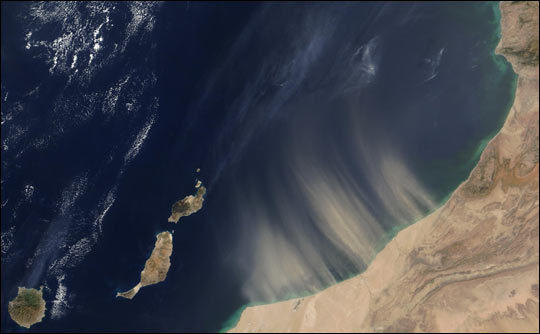
REMOTE SENSING OF
SANDSTORMS

|
|
REMOTE SENSING OF SANDSTORMS |
|
|
What are the sandstorms? Sandstorms appear all around the world but the most dangerous and life threatening sandstorms occur the main three geographic regions as the Middle East, Northern Africa, and Northern China. Countries that get sandstorms are Afghanistan, Algeria, Bahrain, China, Egypt, Iran, Iraq, Israel, Kuwait, Lebanon, Libya, Mongolia, Oman, Qatar, Saudi Arabia, Sudan, Syria, United Arab Emirates and Uzbekistan. Sand and dust storms are natural hazards, the same as smoke, fires, floods, severe storms and volcanoes. The image below shows the locations were natural hazards most likely to occur. . The icons on the above map show the locations of natural hazards observed by NASA satellites. Image obtained from the Internet at http://earthobservatory.nasa.gov/NaturalHazards/natural_hazards_v2.php3?topic=dust |
|
Sand or dust storms are the result of convection currents created by intense heating of the ground. The wind is strong enough to move dunes, and it often interferes with travel, sometimes obliterating roads in flat dry regions. The simoom is the dust- and sand-laden desert wind of N Africa and Arabia that contributes largely to the atmospheric dust over Europe. The haboob is a sandstorm prevalent in the region of Sudan around Khartoum. Sandstorms, the leading edges of which often appear as solid walls of dust as much as 5,000 ft (1,525 m) high, also occur, although less frequently, in the SW United States. (The preceding information was obtained at www.infoplease.com/ce6/weather/A0843423.html ). Sandstorms occur because of dry savanna environment is particularly prone to devastating drought years and desertification. Desertification occurs when land surfaces are transformed by human activities, including overgrazing, deforestation, surface land mining, and poor irrigation techniques, during a natural time of drought. Desertification in the Sahel can largely be attributed to greatly increased numbers of humans and their grazing cattle. Sandstorms are one of the more unpleasant weather phenomena and can be hazardous to transportation and navigation and for human health. Severe or prolonged dust and sand storms also result in major disasters. A dust storm which lasted for 5 hours near Jingchang, China caused 640 million yuan in economic damage over a wide area and injured and killed upwards of 300 people.
The image image obtained from the Internet Dust and sand storms are a persistent problem in Iraq and other areas in the Middle East, but they are most prevalent in the spring and summer months due to the strong winds. The war in Iraq showed us that sandstorms could be a big barrier for the American troops. A severe sandstorm was sweeping across central Iraq when the American forces tried to advance on Baghdad. Dust and high winds reduce visibility to virtually nil, drivers are forced to use global positioning satellites to navigate short distances over familiar territory. Sandstorms restrict the operations of helicopters and jets. The columns of tanks, artillery and other vehicles need to stop in unfamiliar terrain. Dust and sand storms are battering troops and equipment and could complicate plans for an attack. .
Troops have had to sit and wait for the storms to clear. The image image obtained from the Internet at http://news.bbc.co.uk/2/hi/middle_east/2885359.stm
Another big problem is traveling sand. Every year hundred million tons of African dust travels across the Atlantic ocean and settles in the Caribbean, Central America, and South America. Scientists have long known that dust clouds travel long distances. Iron- and clay-rich soils found on many Caribbean islands originated as dust from Africa, and studies show that essential nutrients in Hawaiian rainforests are transported via dust from Asia. A new study, partially funded by NASA, has revealed a surprising connection between red tides in the Gulf of Mexico and giant dust clouds that blow across the Atlantic Ocean from the distant Sahara Desert. NOAA and NASA satellites can spot such dust clouds en route from Africa to the Americas. The West Florida shelf is a hot spot for fishing, aquaculture and tourism, all of which can be drastically affected by a surprise visit from a red tide. Red tides, which are actually blooms of toxic algae, have in the past killed huge numbers of fish, shellfish, marine mammals, and birds. They can also trigger skin and respiratory problems in humans. Levels of asthma on the islands of Barbados and Trinidad are among the highest in the world. (The preceding information was obtained at http://earthobservatory.nasa.gov/Study/Dust).
The image image obtained from the Internet at http://science.nasa.gov/headlines/y2001/ast30aug_1.htm?list85804 Satellites can track African dust clouds as they migrate across the Atlantic Ocean. This NASA TOMS aerosol movie, which spans the interval June 13 through 21, 2001, shows such a cloud raining bits of the Sahara Desert over the Caribbean and the Gulf of Mexico. By using satellites to monitor dust arrivals and blooms research could lead to forecasting of red tides. If you could predict when a red tide is coming, you could close beaches and fisheries ahead of time. (The preceding information was obtained at http://science.nasa.gov/headlines/y2001/ast30aug_1.htm? Sandstorms occur not only on the Earth but on the planet Mars too. Can we predict sandstorms? Timely early warnings of sand and dust storms are critical to preparedness for these, at times, disastrous events. The accurate and early sandstorm forecast can be linked to the satellite remote-sensing monitoring technology as well as to the experience of forecasters. Pictures from meteorological satellites can be transmitted to the ground within several minutes; this greatly helps with the analysis of sandstorm sources, movement and expansion. Can we control sandstorms? Sandstorms are a natural phenomenon and cannot be completely controlled or eliminated. This is especially true in many of the Middle Eastern and African deserts. However, there are many effective preventative measures for more “habitable” regions such as China or the United States. Sandstorms are largely caused by drought, land desertification, irrational utilization of forested land, and overgrazing. Measures like these include avoiding overgrazing, improving use of water resources, restoring farmlands to forests and grasslands, restricting desert development, and further strengthening scientific research. There are currently numerous domestic and international organizations committed to controlling sandstorms, most notably the United Nations Development Program. |